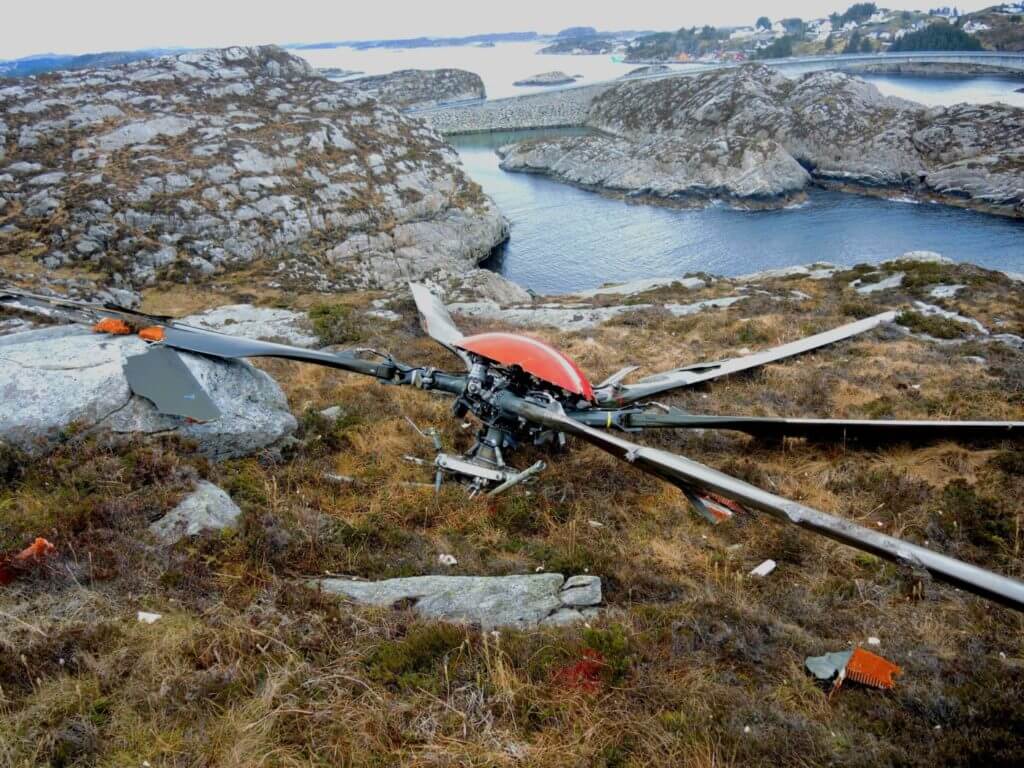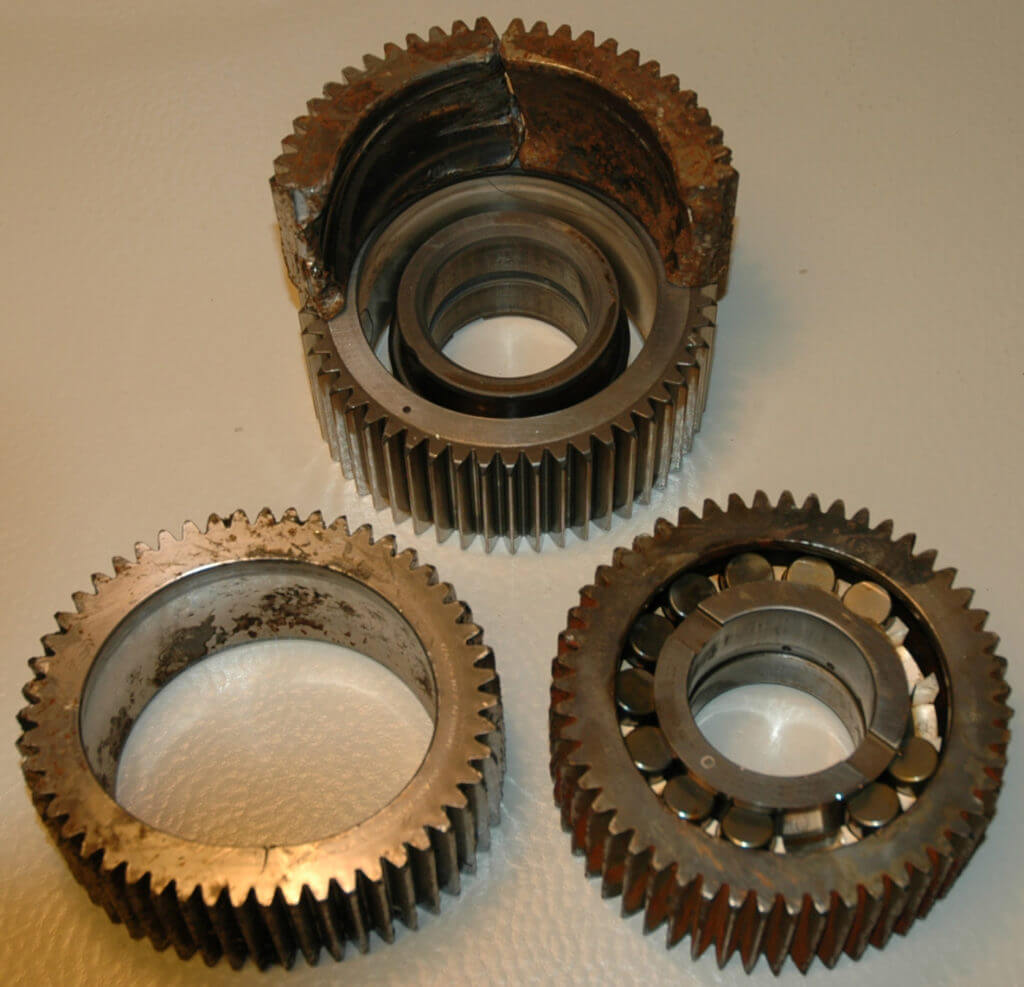The Accident Investigation Board of Norway (AIBN) has called on Airbus Helicopters to revise the type design of the AS332 L2 and H225/EC225 LP, as part of its far-reaching final report into a fatal crash of a Super Puma near Turoy, Norway, in April 2016.

The recommendation to “improve the robustness, reliability and safety of the main gearbox” in the two Super Puma variants was one of 12 safety recommendations in the report. It also targets the European Aviation Safety Agency (EASA), calling on the regulator to revise certification standards for large rotorcraft, commission research into crack development in certain aircraft bearings, and make sure manufacturers’ continuing airworthiness programs cover the examination of critical components found to be beyond serviceable limits.
The cause of the accident, which killed all 13 people on board, was a fatigue fracture in one of eight second stage planet gears in the epicyclic module of the main rotor gearbox, the AIBN report found. This ultimately caused the aircraft’s gearbox to seize and rupture, leading to the detachment of the main rotor.
The aircraft — LN-OJF — was a CHC-operated H225, and was returning to Bergen Airport Flesland from Gullfaks B platform in the North Sea. It had just descended to 2,000 feet and was in cruise at 140 knots at the time of the failure. The AIBN said cockpit recordings showed the crew had received “no warnings” before the main rotor detached. The cockpit recording ended almost immediately, but data from health and usage monitoring systems showed the aircraft yawing and rolling to the right, impacting a small island about 13 seconds after the main rotor detached. It ultimately landed about 550 meters away from the main crash site.
The AIBN’s analysis found the fatigue fracture began at the surface of the upper outer race of the planet gear bearing, initiating from a surface micro-pit and propagating below the surface.
“The combination of material properties, surface treatment, design, operational loading environment and debris gave rise to a failure mode which was not previously anticipated or assessed,” the report states. “The failure developed in a manner which was unlikely to be detected by the maintenance procedures and the monitoring systems fitted to LN-OJF at the time of the accident.”

Indeed, the report notes that the gearbox had just 1,080 flight hours when it was installed in LN-OJF, and 1,340 flight hours at the time of the accident. During that time CHC had completed six visual inspections of the gearbox chip detectors without finding any chips.
The unanticipated nature of the failure was an area of particular focus for investigators, given the clear parallels they draw to the fatal crash of an AS332 L2 off the coast of Scotland in 2009 that killed 16 people. In that aircraft (G-REDL), the main rotor also detached following what was later discovered to be a fatigue fracture in a second stage planet gear.
“However, the post-investigation actions were not sufficient to prevent another main rotor loss,” the Norwegian report notes, adding that “the [G-REDL] accident was not fully understood at that time due to the lack of some essential wreckage parts.”
Design Concerns
The report notes that the design of the second stage planet gears in the AS332 L2 and H225/EC225 LP was based on earlier AS332 L/L1 and SA330 Puma gearboxes. The architecture of the L2’s epicyclic module was based on the L1, but it was fitted with eight larger diameter planet gears rather than the nine in the L1.
Bearing manufacturers FAG and NTN-SNR supplied planet gear bearings for the L2’s epicyclic module, and, during the design of the H225/EC225 LP, Airbus asked them to re-evaluate the epicyclic module planet gears for use in the more powerful new aircraft. According to the AIBN report, Airbus concluded that the epicyclic module was capable of withstanding the H225/EC225 LP’s higher operational loads without change in design, but it gave different operational time limits (OTL) for the two variants: 4,400 flight hours in the H225/EC225 LP, and 6,600 flight hours in the L2.
During the AIBN’s investigation, it found that no FAG-supplied second stage planet gears reached their intended OTL of 4,400 hours before being scrapped during inspection, and only about 10 percent of NTN-SNR planet gears did. The report notes that between the dates of the G-REDL accident in 2009 and the LN-OJF accident, Airbus Helicopters did not section and inspect any of these second stage planet gears.

The investigators also noted dimensional differences between internal bearing parts manufactured by the two suppliers. Airbus Helicopters told the AIBN it had “no reason to regard the potential differences in performance of the planet gears as a contributing factor at the time” of the G-REDL crash, the AIBN report notes, and it wasn’t noted in the report of that accident.
“Airbus Helicopters considered the [G-REDL] accident as mainly a result of maintenance error and additional safety measures were introduced to improve the chip detection system,” the report states. “Hence, they did not regard the performance of the planet gear bearings as a significant safety factor at the time. In contrast, during the LN-OJF investigation the performance difference between FAG and NTN-SNR has been a significant issue.”
Following the crash of LN-OJF, the H225/EC225 LP and AS332 L2 fleets were grounded by regulatory agencies around the world, and as part of the types’ return to service following the grounding, Airbus implemented a variety of safety measures. Among these were the removal of FAG planet gears from service, and the reduction of the service life limit of the planet gears to 1,100 flight hours for the H225/EC225 LP and 1,650 flight hours for the AS332 L2.
“The introduction of service life limit for the second stage planet gears and the latest reduction to 1,100 flight hours, indicate that the design initially did not possess sufficient robustness for the EC225 LP application,” the report states.
“Two catastrophic events and the service experience of few second stage planet gears reaching their operating time limit, may suggest that the operational loading environment, on both AS332 L2 and EC225 LP, is close to the limit of endurance for the design.

“New continuing airworthiness requirements and ADs reacting to service experience should be temporary safety measures only. To address the permanent solution changes to the type design should be considered.”
A raft of recommendations
The investigators said they still don’t fully understand the failure mode — a failure that was not previously anticipated or assessed — and as such, have recommended to EASA to commission research into crack development in certain aircraft bearings.
And, as the chip detection system in the accident aircraft didn’t find any warning of the impending failure, the AIBN recommended EASA revise the certification specifications for large rotorcraft to introduce requirements for chip detection performance.
Following that, given that it might not be possible to assess the fatigue reliability of internal gearbox components, it recommends EASA require a fail-safe main gearbox, in which no failure of an internal component leads to a catastrophic failure.
In response to the AIBN report, Airbus Helicopters said it expressed “deep regret” for the accident and welcomed the conclusion of the investigation.
“Neither aviation authorities nor industry had ever seen the type of crack in the main gear box that led to the LN-OJF accident,” the company said in a statement. “Extensive analysis of the accident has led to the development of a set of safety measures, approved by global aviation authorities, which have allowed the H225 fleet to resume flight operations worldwide.”

In addition to the changes impacting the second stage planet gears, the safety measures implemented by Airbus included the installation of a full flow magnetic plug to collect main gearbox particles upstream of the oil cooler, intensified maintenance inspections, and the removal of epicyclic modules from service that had been subject to unusual events.
“Today, as a result of the measures introduced by Airbus Helicopters and approved by global and national aviation authorities, including the UK and Norwegian CAAs, the H225 meets the most stringent, global airworthiness standards,” said Airbus.
“The company continues to work on incremental improvements to the H225 as part of its ongoing, continuous improvement process.”









